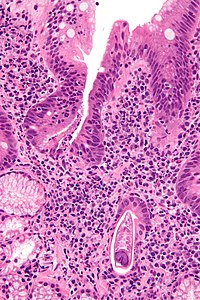
Strongyloides stercoralis hyperinfection syndrome: a known entity in an unknown provenance
Sign Up to like & getrecommendations! Published in 2022 at "BMJ Case Reports"
DOI: 10.1136/bcr-2021-242698
Abstract: A 49-year-old man was admitted with altered mental status, high-grade fevers, tachycardia and leucocytosis. Cerebrospinal fluid (CSF) was purulent with a markedly elevated nucleated cell count with neutrophilic predominance, elevated protein and low glucose. CSF… read more here.
Keywords: hyperinfection syndrome; syndrome known; stercoralis hyperinfection; strongyloides stercoralis ... See more keywords

Strongyloides stercoralis hyperinfection syndrome with cerebral involvement
Sign Up to like & getrecommendations! Published in 2022 at "BMJ Case Reports"
DOI: 10.1136/bcr-2021-247032
Abstract: Strongyloidiasis is a disease caused by the intestinal helminth Strongyloides stercoralis. When the immune system of infected individuals is compromised, larvae may migrate from the gastrointestinal tract to other tissues, causing S. stercoralis hyperinfection syndrome,… read more here.
Keywords: hyperinfection syndrome; involvement; stercoralis hyperinfection; strongyloides stercoralis ... See more keywords

Strongyloides and COVID-19: Challenges and Opportunities for Future Research
Sign Up to like & getrecommendations! Published in 2023 at "Tropical Medicine and Infectious Disease"
DOI: 10.3390/tropicalmed8020127
Abstract: Strongyloides stercoralis is a soil transmitted helminth endemic to tropical and subtropical areas that can persist for decades in immunocompetent human hosts as a chronic asymptomatic infection. The use of corticosteroids, a mainstay of treatment… read more here.
Keywords: future research; treatment; hyperinfection syndrome;

Strongyloid Hyperinfection Syndrome in a Renal Transplant Recipient
Sign Up to like & getrecommendations! Published in 2017 at "Indian Journal of Nephrology"
DOI: 10.4103/ijn.ijn_246_16
Abstract: Roentgenogram of the abdomen revealed distended bowel loops. Esophageal endoscopy done for odynophagia revealed ulcerations in the esophagus. Small pin head‐sized white patches in the duodenum were biopsied and they revealed Schistosomal larvae and adult… read more here.
Keywords: transplant recipient; hyperinfection syndrome; renal transplant; syndrome renal ... See more keywords